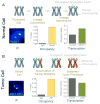Mitotic bookmarking of genes: a novel dimension to epigenetic control
- PMID: 20628351
- PMCID: PMC3033599
- DOI: 10.1038/nrg2827
Mitotic bookmarking of genes: a novel dimension to epigenetic control
Abstract
Regulatory machinery is focally organized in the interphase nucleus. The information contained in these focal nuclear microenvironments must be inherited during cell division to sustain physiologically responsive gene expression in progeny cells. Recent results suggest that focal mitotic retention of phenotypic transcription factors at promoters together with histone modifications and DNA methylation--a mechanism collectively known as gene bookmarking--is a novel parameter of inherited epigenetic control that sustains cellular identity after mitosis. The epigenetic signatures imposed by bookmarking poise genes for activation or suppression following mitosis. We discuss the implications of phenotypic transcription factor retention on mitotic chromosomes in biological control and disease.
Figures



References
-
- Urnov FD, Wolffe AP. Above and within the genome: epigenetics past and present. J Mammary Gland Biol Neoplasia. 2001;6:153–167. - PubMed
-
- Goldberg AD, Allis CD, Bernstein E. Epigenetics: a landscape takes shape. Cell. 2007;128:635–638. - PubMed
-
- Berger SL. The complex language of chromatin regulation during transcription. Nature. 2007;447:407–412. - PubMed
-
- Nelson CJ, Santos-Rosa H, Kouzarides T. Proline isomerization of histone H3 regulates lysine methylation and gene expression. Cell. 2006;126:905–916. - PubMed
-
- Cuthbert GL, et al. Histone deimination antagonizes arginine methylation. Cell. 2004;118:545–553. - PubMed
Publication types
MeSH terms
Substances
Grants and funding
LinkOut - more resources
Full Text Sources

